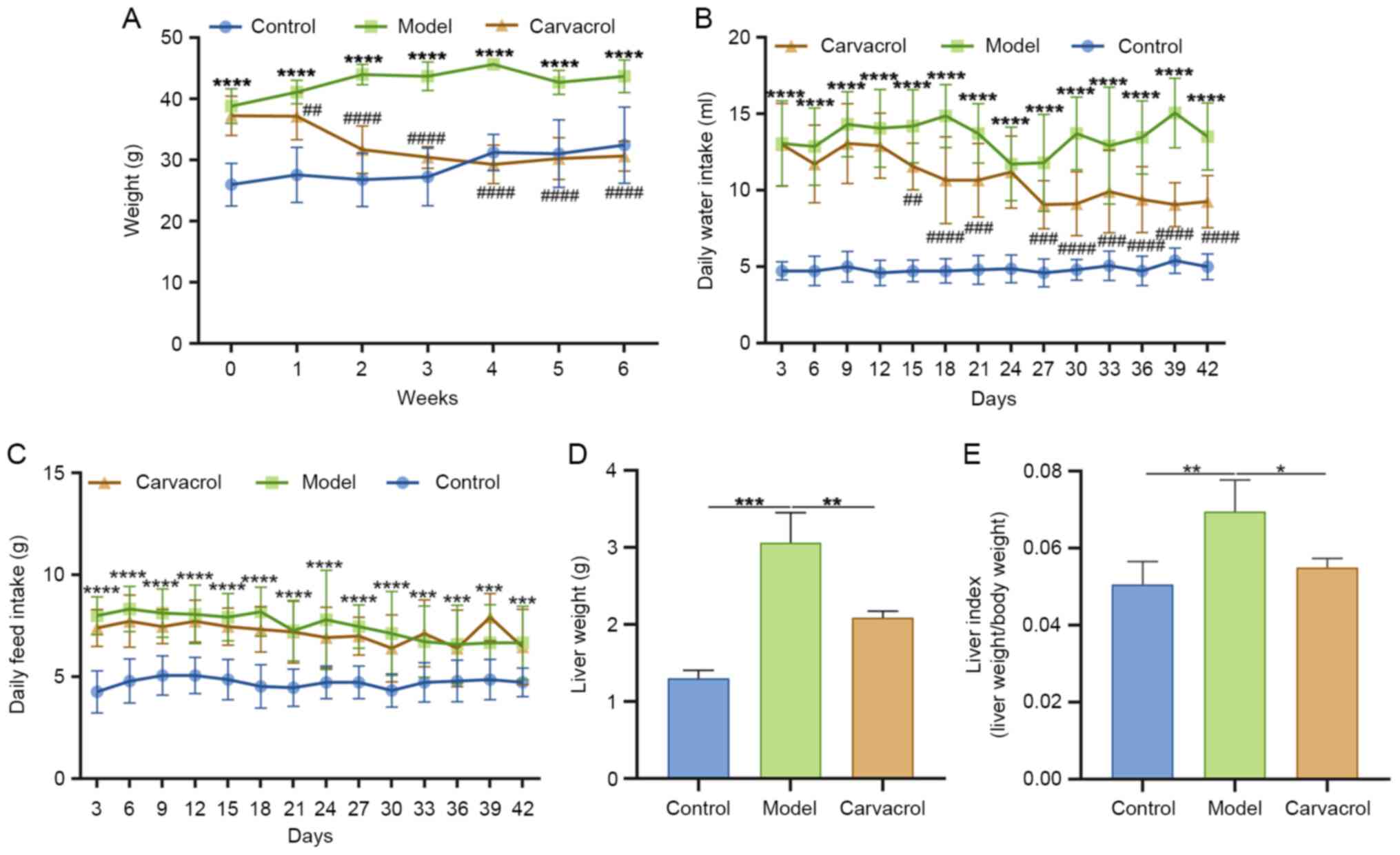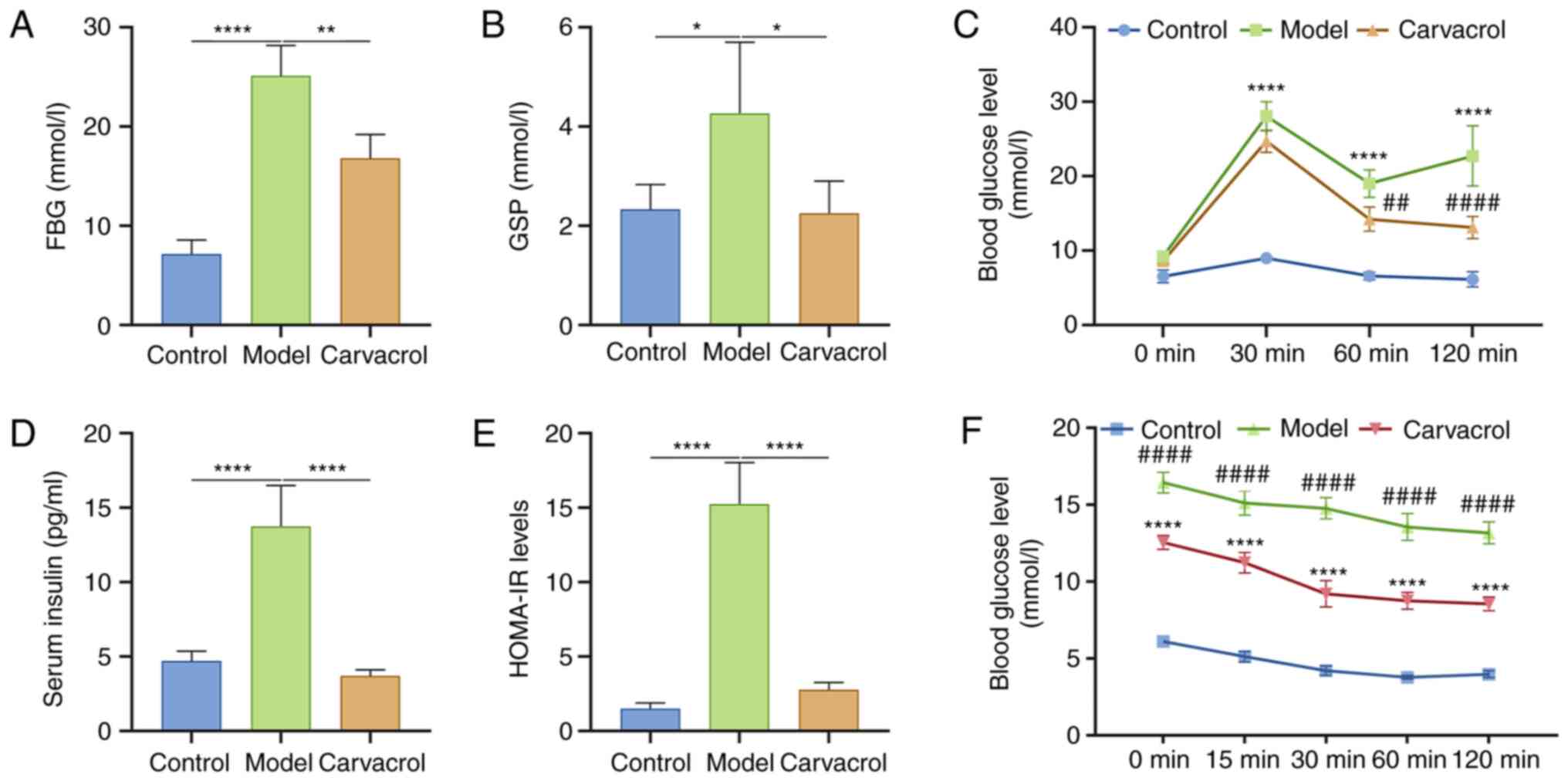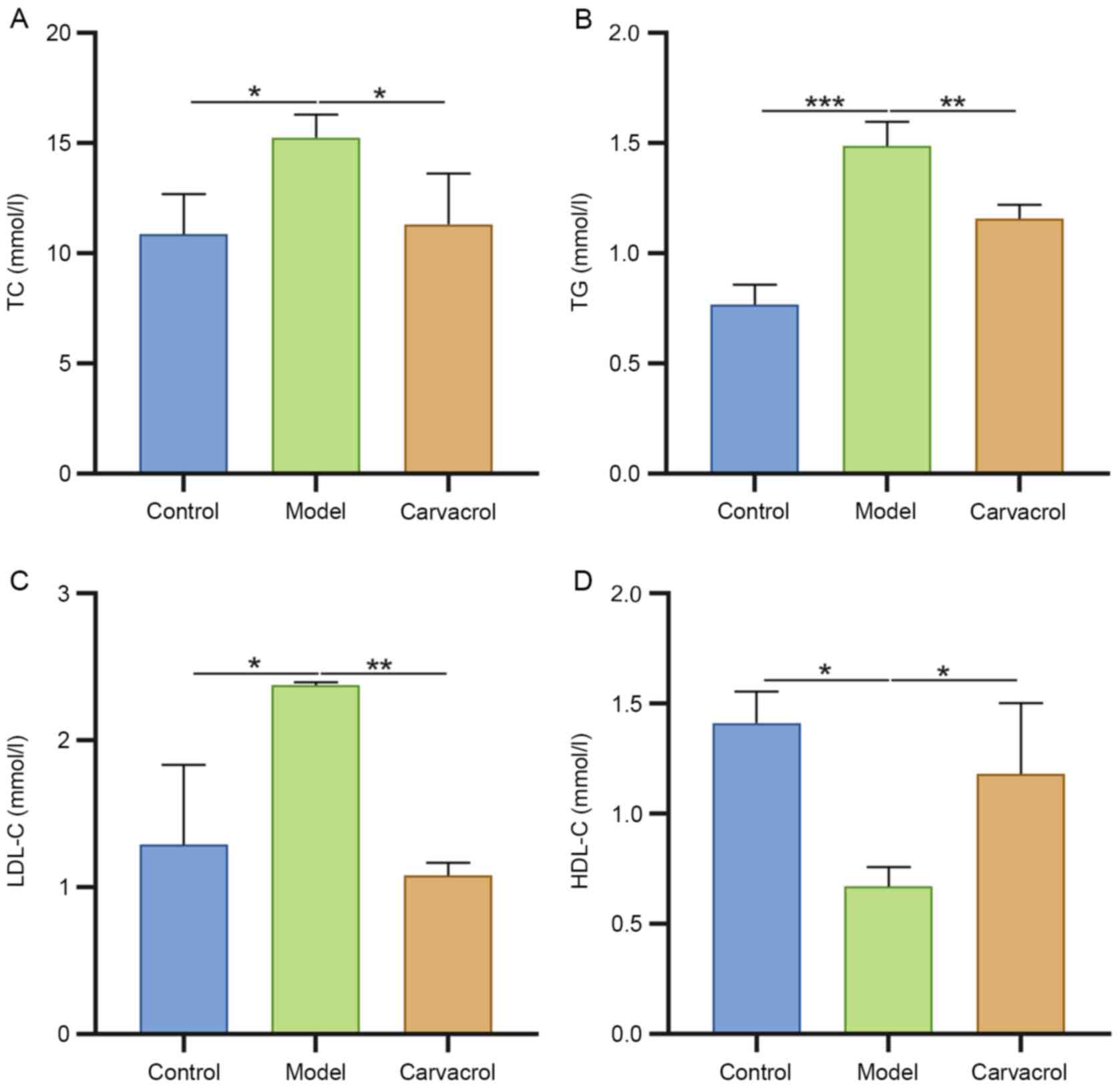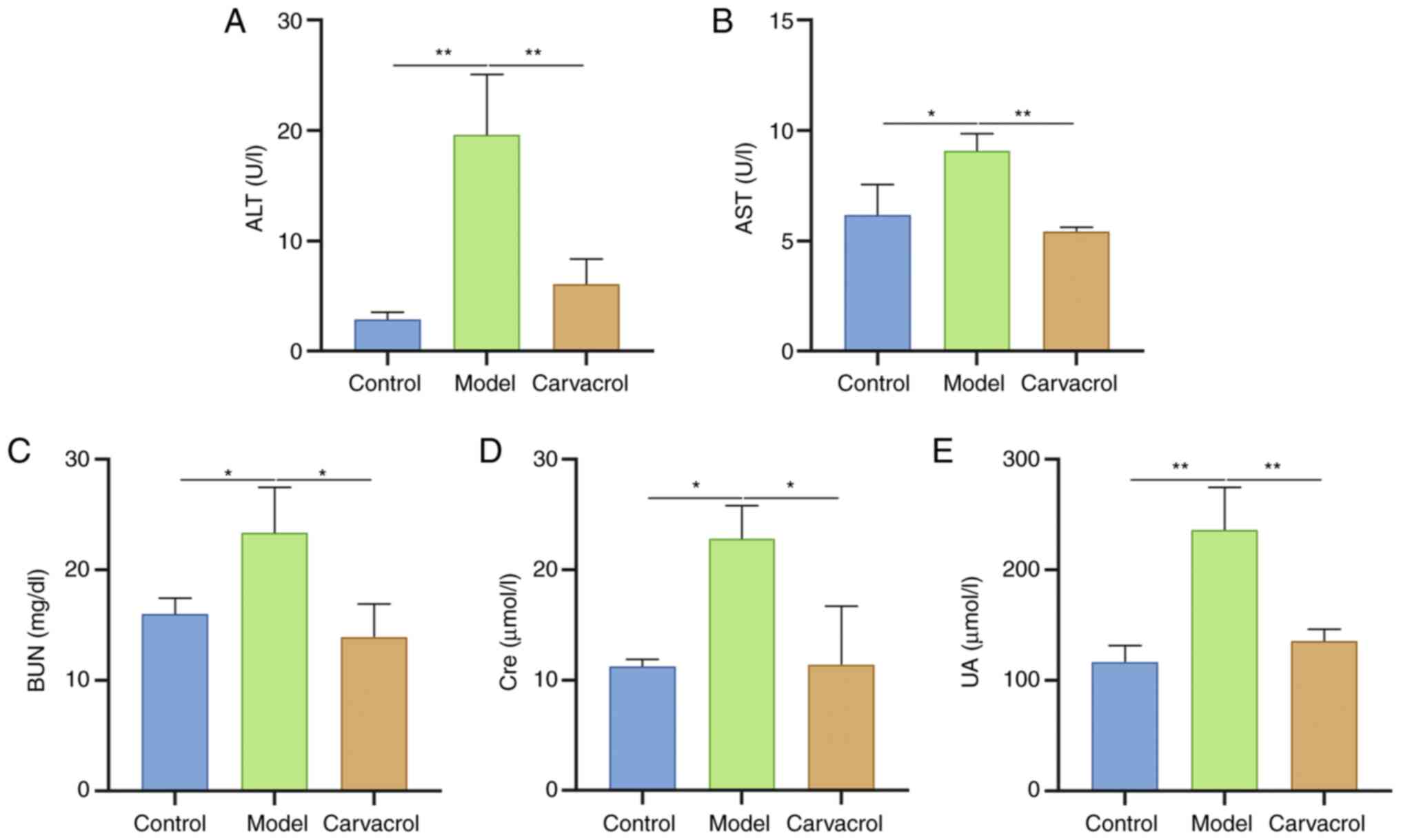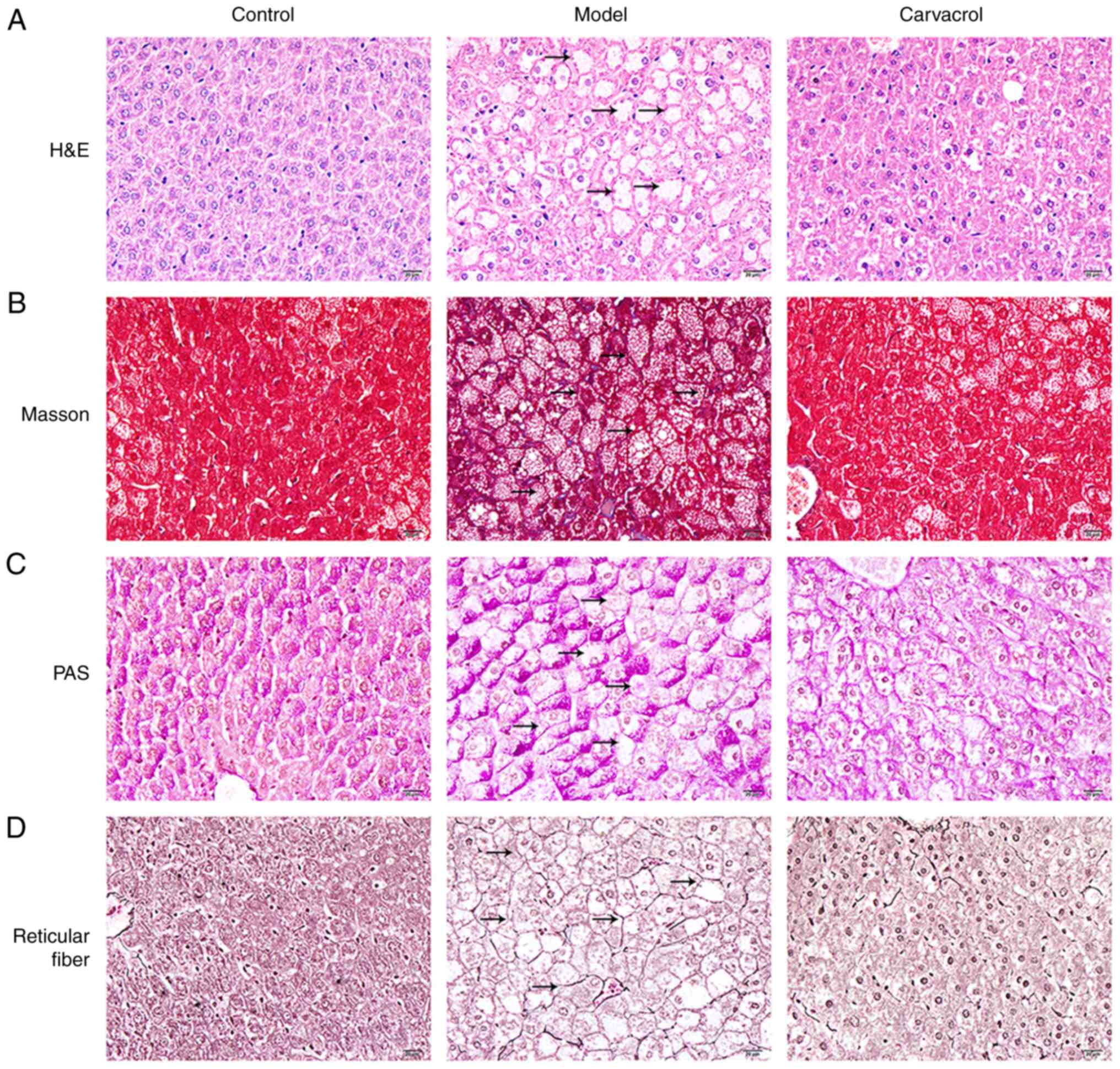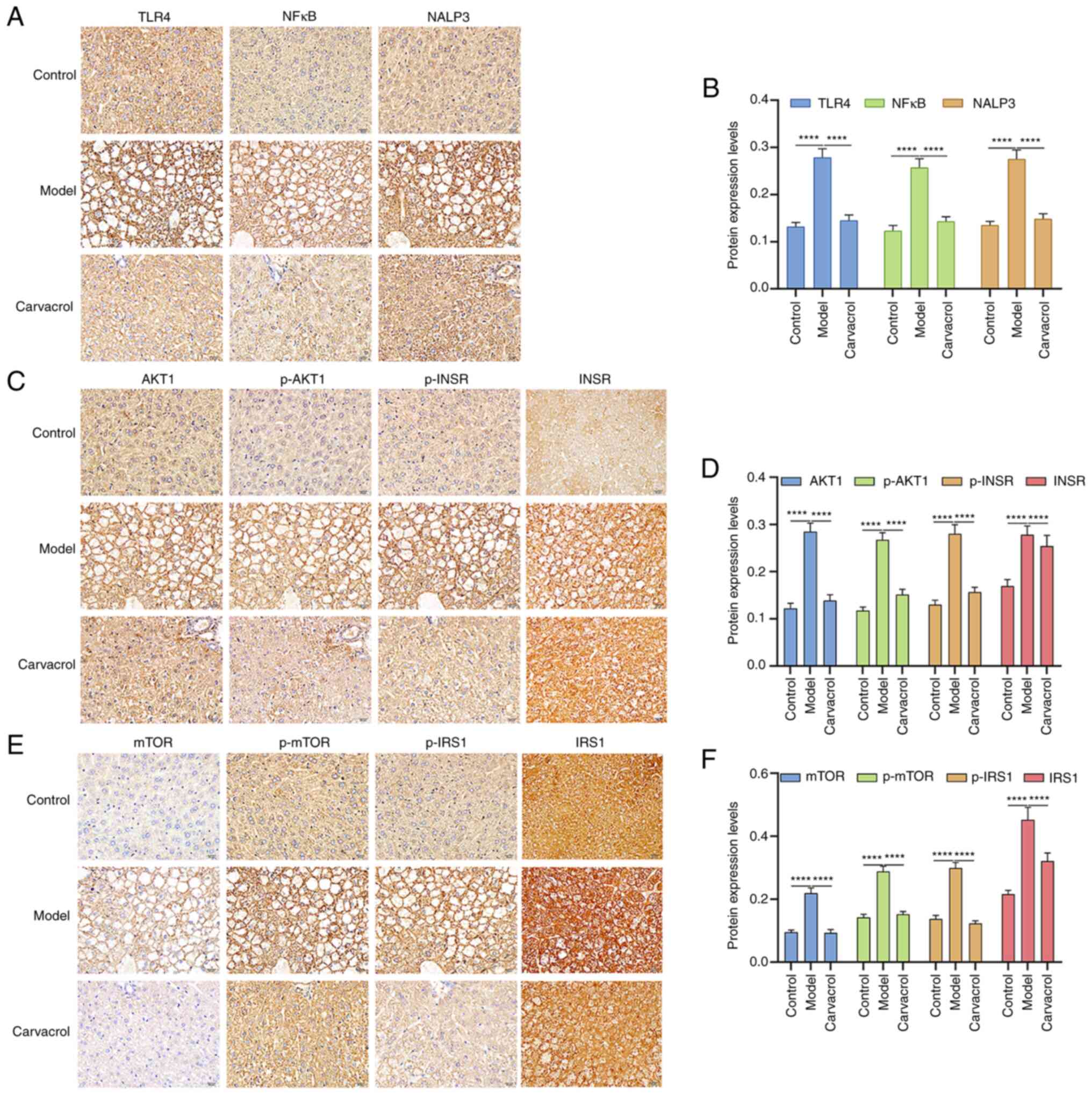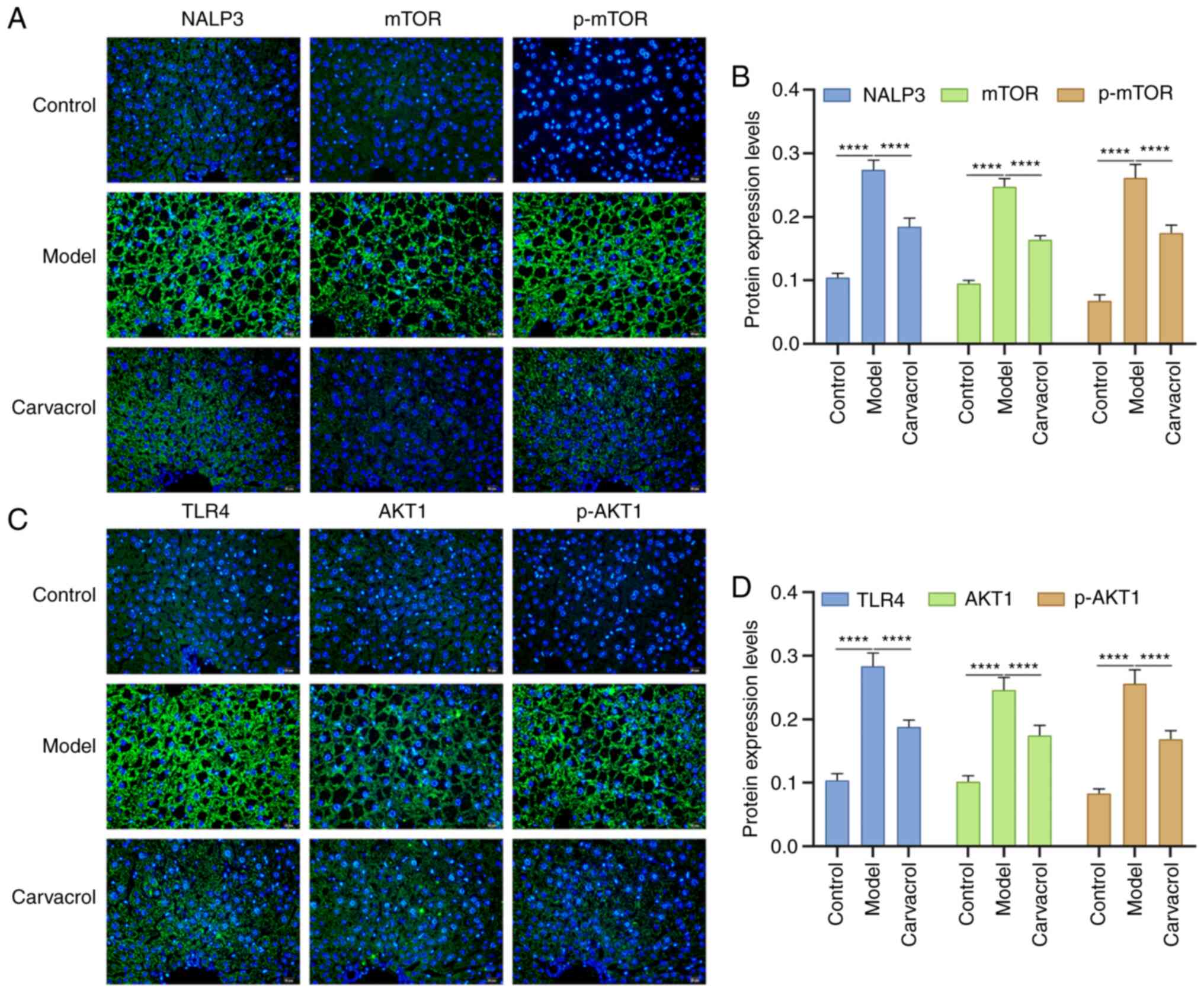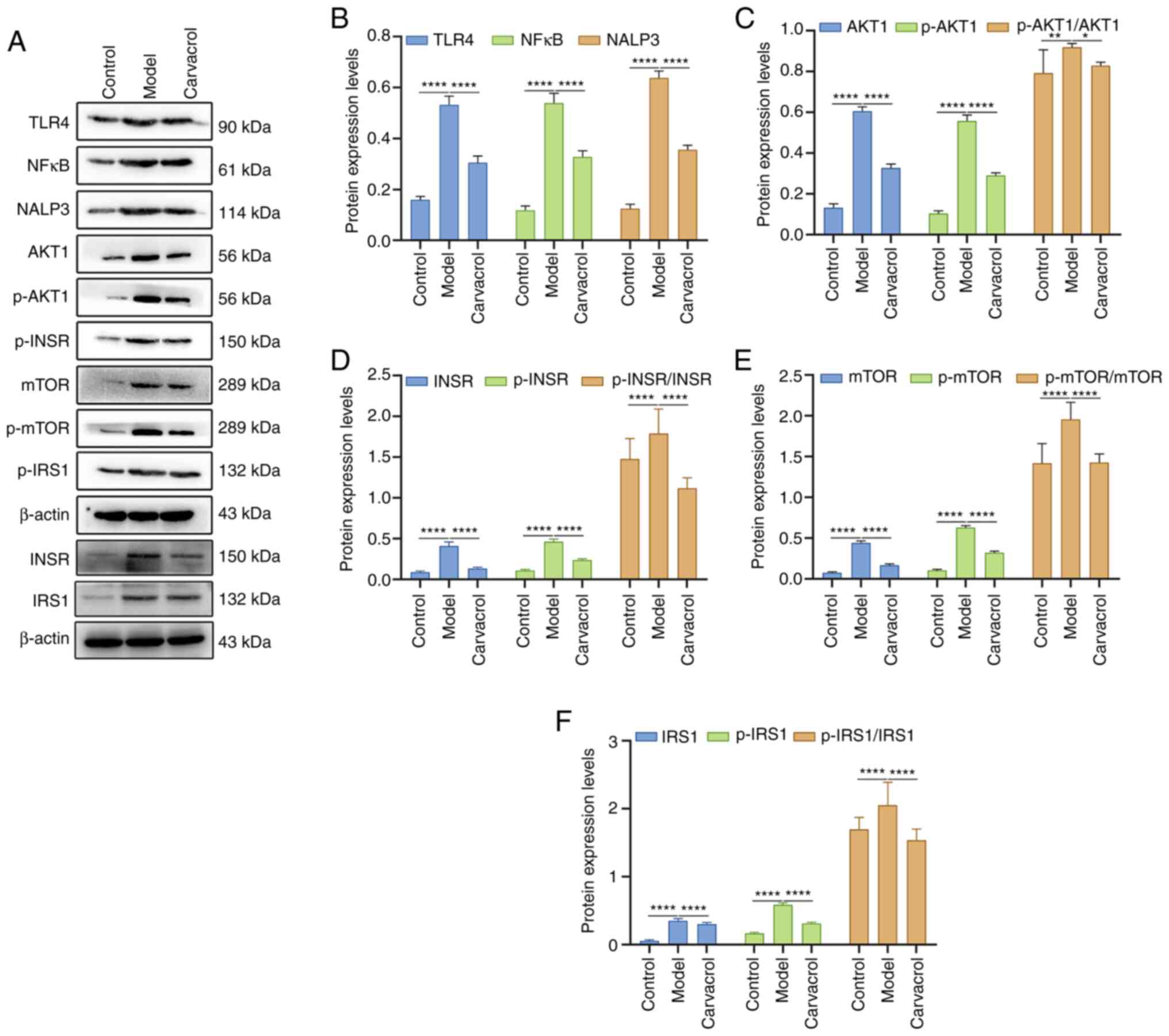|
1
|
Liang W, Zhang D, Kang J, Meng X, Yang J,
Yang L, Xue N, Gao Q, Han S and Gou X: Protective effects of rutin
on liver injury in type 2 diabetic db/db mice. Biomed Pharmacother.
107:721–728. 2018. View Article : Google Scholar : PubMed/NCBI
|
|
2
|
Guariguata L, Whiting DR, Hambleton I,
Beagley J, Linnenkamp U and Shaw JE: Global estimates of diabetes
prevalence for 2013 and projections for 2035. Diabetes Res Clin
Pract. 103:137–149. 2014. View Article : Google Scholar : PubMed/NCBI
|
|
3
|
Younossi Z, Tacke F, Arrese M, Chander
Sharma B, Mostafa I, Bugianesi E, Wai-Sun Wong V, Yilmaz Y, George
J, Fan J and Vos MB: Global perspectives on nonalcoholic fatty
liver disease and nonalcoholic steatohepatitis. Hepatology.
69:2672–2682. 2019. View Article : Google Scholar : PubMed/NCBI
|
|
4
|
Yang H, Yang T, Heng C, Zhou Y, Jiang Z,
Qian X, Du L, Mao S, Yin X and Lu Q: Quercetin improves
nonalcoholic fatty liver by ameliorating inflammation, oxidative
stress, and lipid metabolism in db/db mice. Phytother Res.
33:3140–3152. 2019. View
Article : Google Scholar : PubMed/NCBI
|
|
5
|
Chang TC, Chiang H, Lai YH, Huang YL,
Huang HC, Liang YC, Liu HK and Huang C: Helminthostachys
zeylanica alleviates hepatic steatosis and insulin resistance
in diet-induced obese mice. BMC Complement Altern Med. 19:3682019.
View Article : Google Scholar : PubMed/NCBI
|
|
6
|
Leung PS: The Modulatory action of Vitamin
D on the Renin-Angiotensin System and the determination of hepatic
insulin resistance. Molecules. 24:24792019. View Article : Google Scholar : PubMed/NCBI
|
|
7
|
Wang CC, Cheng PN and Kao JH: Systematic
review: Chronic viral hepatitis and metabolic derangement. Aliment
Pharmacol Ther. 51:216–230. 2020. View Article : Google Scholar : PubMed/NCBI
|
|
8
|
Li DJ, Liu J, Hua X, Fu H, Huang F, Fei
YB, Lu WJ, Shen FM and Wang P: Nicotinic acetylcholine receptor α7
subunit improves energy homeostasis and inhibits inflammation in
nonalcoholic fatty liver disease. Metabolism. 79:52–63. 2018.
View Article : Google Scholar : PubMed/NCBI
|
|
9
|
Liu C, Liao JZ and Li PY: Traditional
Chinese herbal extracts inducing autophagy as a novel approach in
therapy of nonalcoholic fatty liver disease. World J Gastroenterol.
23:1964–1973. 2017. View Article : Google Scholar : PubMed/NCBI
|
|
10
|
Scheen AJ: Beneficial effects of SGLT2
inhibitors on fatty liver in type 2 diabetes: A common comorbidity
associated with severe complications. Diabetes Metab. 45:213–223.
2019. View Article : Google Scholar : PubMed/NCBI
|
|
11
|
Guan X, Li X, Yang X, Yan J, Shi P, Ba L,
Cao Y and Wang P: The neuroprotective effects of carvacrol on
ischemia/reperfusion-induced hippocampal neuronal impairment by
ferroptosis mitigation. Life Sci. 235:1167952019. View Article : Google Scholar : PubMed/NCBI
|
|
12
|
Zhao W, Deng C, Han Q, Xu H and Chen Y:
Carvacrol may alleviate vascular inflammation in diabetic db/db
mice. Int J Mol Med. 46:977–988. 2020. View Article : Google Scholar : PubMed/NCBI
|
|
13
|
de Carvalho FO, Silva ÉR, Gomes IA,
Santana HS, do Nascimento Santos D, de Oliveira Souza GP, de Jesus
Silva D, Monteiro JC, de Albuquerque Júnior RLC, de Souza Araújo AA
and Nunes PS: Anti-inflammatory and antioxidant activity of
carvacrol in the respiratory system: A systematic review and
meta-analysis. Phytother Res. 34:2214–2229. 2020. View Article : Google Scholar : PubMed/NCBI
|
|
14
|
Cardoso AD, Santos EG, Lima AD, Temeyer
KB, Pérez de León AA, Costa LM Junior and Soares AM: Terpenes on
Rhipicephalus (Boophilus) microplus: Acaricidal activity and
acetylcholinesterase inhibition. Vet Parasitol. 280:1090902020.
View Article : Google Scholar : PubMed/NCBI
|
|
15
|
Trindade GG, Thrivikraman G, Menezes PP,
França CM, Lima BS, Carvalho YM, Souza EP, Duarte MC, Shanmugam S,
Quintans-Júnior LJ, et al: Carvacrol/β-cyclodextrin inclusion
complex inhibits cell proliferation and migration of prostate
cancer cells. Food Chem Toxicol. 125:198–209. 2019. View Article : Google Scholar : PubMed/NCBI
|
|
16
|
Liu Y, Wei J, Ma KT, Li CL, Mai YP, Qiu
XX, Wei H, Hou N and Luo JD: Carvacrol protects against
diabetes-induced hypercontractility in the aorta through activation
of the PI3K/Akt pathway. Biomed Pharmacother. 125:1098252020.
View Article : Google Scholar : PubMed/NCBI
|
|
17
|
Hou N, Mai Y, Qiu X, Yuan W, Li Y, Luo C,
Liu Y, Zhang G, Zhao G and Luo JD: Carvacrol attenuates diabetic
cardiomyopathy by modulating the PI3K/AKT/GLUT4 Pathway in diabetic
mice. Front Pharmacol. 10:9982019. View Article : Google Scholar : PubMed/NCBI
|
|
18
|
Kobayashi K, Forte TM, Taniguchi S, Ishida
BY, Oka K and Chan L: The db/db mouse, a model for diabetic
dyslipidemia: Molecular characterization and effects of Western
diet feeding. Metabolism. 49:22–31. 2000. View Article : Google Scholar : PubMed/NCBI
|
|
19
|
Peng BY, Wang Q, Luo YH, He JF, Tan T and
Zhu H: A novel and quick PCR-based method to genotype mice with a
leptin receptor mutation (db/db mice). Acta Pharmacol Sin.
39:117–123. 2018. View Article : Google Scholar : PubMed/NCBI
|
|
20
|
National Research Council Committee for
the Update of the Guide for the C, Use of Laboratory A. The
National Academies Collection, . Reports funded by National
Institutes of Health. Guide for the Care and Use of Laboratory
Animals. National Academies Press; Washington, DC: 2011, PubMed/NCBI
|
|
21
|
Emoto M, Nishizawa Y, Maekawa K, Hiura Y,
Kanda H, Kawagishi T, Shoji T, Okuno Y and Morii H: Homeostasis
model assessment as a clinical index of insulin resistance in type
2 diabetic patients treated with sulfonylureas. Diabetes Care.
22:818–822. 1999. View Article : Google Scholar : PubMed/NCBI
|
|
22
|
Prasanna PL, Renu K and Valsala
Gopalakrishnan A: New molecular and biochemical insights of
doxorubicin-induced hepatotoxicity. Life Sci. 250:1175992020.
View Article : Google Scholar : PubMed/NCBI
|
|
23
|
Sampath Kumar A, Maiya AG, Shastry BA,
Vaishali K, Ravishankar N, Hazari A, Gundmi S and Jadhav R:
Exercise and insulin resistance in type 2 diabetes mellitus: A
systematic review and meta-analysis. Ann Phys Rehabil Med.
62:98–103. 2019. View Article : Google Scholar : PubMed/NCBI
|
|
24
|
Zheng Y, Liu T, Wang Z, Xu Y, Zhang Q and
Luo D: Low molecular weight fucoidan attenuates liver injury via
SIRT1/AMPK/PGC1α axis in db/db mice. Int J Biol Macromol.
112:929–936. 2018. View Article : Google Scholar : PubMed/NCBI
|
|
25
|
Kim KE, Jung Y, Min S, Nam M, Heo RW, Jeon
BT, Song DH, Yi CO, Jeong EA, Kim H, et al: Caloric restriction of
db/db mice reverts hepatic steatosis and body weight with divergent
hepatic metabolism. Sci Rep. 6:301112016. View Article : Google Scholar : PubMed/NCBI
|
|
26
|
Eckel RH, Grundy SM and Zimmet PZ: The
metabolic syndrome. Lancet. 365:1415–1428. 2005. View Article : Google Scholar : PubMed/NCBI
|
|
27
|
Meng Q, Qi X, Fu Y, Chen Q, Cheng P, Yu X,
Sun X, Wu J, Li W, Zhang Q, et al: Flavonoids extracted from
mulberry (Morus alba L.) leaf improve skeletal muscle
mitochondrial function by activating AMPK in type 2 diabetes. J
Ethnopharmacol. 248:1123262020. View Article : Google Scholar : PubMed/NCBI
|
|
28
|
Berk PD and Verna EC: Nonalcoholic fatty
liver disease: Lipids and insulin resistance. Clin Liver Dis.
20:245–262. 2016. View Article : Google Scholar : PubMed/NCBI
|
|
29
|
Sattar N, Fitchett D, Hantel S, George JT
and Zinman B: Empagliflozin is associated with improvements in
liver enzymes potentially consistent with reductions in liver fat:
Results from randomised trials including the EMPA-REG
OUTCOME® trial. Diabetologia. 61:2155–2163. 2018.
View Article : Google Scholar : PubMed/NCBI
|
|
30
|
Liu HW, Kao HH and Wu CH: Exercise
training upregulates SIRT1 to attenuate inflammation and metabolic
dysfunction in kidney and liver of diabetic db/db mice. Nutr Metab
(Lond). 16:222019. View Article : Google Scholar : PubMed/NCBI
|
|
31
|
Cobbina E and Akhlaghi F: Non-alcoholic
fatty liver disease (NAFLD)-pathogenesis, classification, and
effect on drug metabolizing enzymes and transporters. Drug Metab
Rev. 49:197–211. 2017. View Article : Google Scholar : PubMed/NCBI
|
|
32
|
Mohseni R, Karimi J, Tavilani H, Khodadadi
I and Hashemnia M: Carvacrol ameliorates the progression of liver
fibrosis through targeting of Hippo and TGF-β signaling pathways in
carbon tetrachloride (CCl4)-induced liver fibrosis in
rats. Immunopharmacol Immunotoxicol. 41:163–171. 2019. View Article : Google Scholar : PubMed/NCBI
|
|
33
|
Ozen BD and Uyanoglu M: Effect of
carvacrol on IL-6/STAT3 pathway after partial hepatectomy in rat
liver. Bratisl Lek Listy. 119:593–601. 2018.PubMed/NCBI
|
|
34
|
Ding S, Xu S, Ma Y, Liu G, Jang H and Fang
J: Modulatory mechanisms of the NLRP3 inflammasomes in diabetes.
Biomolecules. 9:8502019. View Article : Google Scholar : PubMed/NCBI
|
|
35
|
Yin H, Huang L, Ouyang T and Chen L:
Baicalein improves liver inflammation in diabetic db/db mice by
regulating HMGB1/TLR4/NF-κB signaling pathway. Int Immunopharmacol.
55:55–62. 2018. View Article : Google Scholar : PubMed/NCBI
|
|
36
|
Liu ZM, Zheng HY, Chen LH, Li YL, Wang Q,
Liao CF and Li XW: Low expression of miR-203 promoted diabetic
nephropathy via increasing TLR4. Eur Rev Med Pharmacol Sci.
22:5627–5634. 2018.PubMed/NCBI
|
|
37
|
Yi H, Peng R, Zhang LY, Sun Y, Peng HM,
Liu HD, Yu LJ, Li AL, Zhang YJ, Jiang WH and Zhang Z:
LincRNA-Gm4419 knockdown ameliorates NF-κB/NLRP3
inflammasome-mediated inflammation in diabetic nephropathy. Cell
Death Dis. 8:e25832017. View Article : Google Scholar : PubMed/NCBI
|
|
38
|
Pomytkin I, Krasil'nikova I, Bakaeva Z,
Surin A and Pinelis V: Excitotoxic glutamate causes neuronal
insulin resistance by inhibiting insulin receptor/Akt/mTOR pathway.
Mol Brain. 12:1122019. View Article : Google Scholar : PubMed/NCBI
|
|
39
|
Villalobos-Labra R, Silva L, Subiabre M,
Araos J, Salsoso R, Fuenzalida B, Sáez T, Toledo F, González M,
Quezada C, et al: Akt/mTOR role in human foetoplacental vascular
insulin resistance in diseases of pregnancy. J Diabetes Res.
2017:59478592017. View Article : Google Scholar : PubMed/NCBI
|















